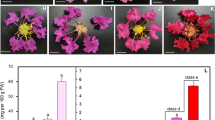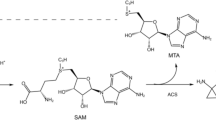Abstract
Key message
In this study, we carried out cDNA-AFLP analysis on petals of 2 Osmanthus fragrans cultivars, yielding 102 cDNA fragments. OfMYB1 gene was cloned and the molecular characteristics were studied.
Abstract
The Osmanthus fragrans cultivars ‘Dangui’ and ‘Yingui’ differ considerably in floral coloration and volatiles. We carried out cDNA-AFLP analysis on petals of the two cultivars to isolate genes involved in the production of floral pigments and aromatic chemicals. Using 256 primer combinations, we detected 390 differentially expressed fragments, yielding 102 cDNA fragments. Of the differentially expressed transcripts, 45 were upregulated in ‘Yingui’ and 57 were upregulated in ‘Dangui’. The differentially expressed genes were involved in several metabolic and signal transduction pathways. According to the cDNA-AFLP analysis, a 72-bp fragment was upregulated in ‘Dangui’, sequence comparison of the differentially expressed transcript-derived fragment showed this to be a MYB transcription factor. The cDNA of OfMYB1 was 749 bp long and contained a coding sequence of 585 bp encoding a polypeptide of 195 amino acids. A phylogenetic analysis placed the OfMYB1 gene within the subgroup containing “nyWsV/M E/DDlWP/S” motif. Protoplast transformation experiment showed that OfMYB1 protein accumulated in cell nuclei. Yeast one hybrid assay confirmed that OfMYB1 acted as a transcriptional activator to regulate expression of OfPAL gene. The differential expression patterns of OfMYB1 and anthocyanin biosynthetic pathway genes (OfCHS, OfCHI, OfDFR and OfANS) in the 2 O. fragrans cultivars suggested that OfMYB1 may not regulate the expression of these genes.






Similar content being viewed by others
References
Bachem CW, van der Hoeven RS, de Bruijn SM, Vreugdenhil D, Zabeau M, Visser RG (1996) Visualization of differential gene expression using a novel method of RNA fingerprinting based on AFLP: analysis of gene expression during potato tuber development. Plant J 9:745–753
Bohlmann J, Meyer-Gauen G, Croteau R (1998) Plant terpenoid synthases: molecular biology and phylogenetic analysis. PNAS 95(8):4126–4133
Dairi T (2005) Studies on biosynthetic genes and enzymes of isoprenoids produced by actinomycetes. J Antibiot 58(4):227–243
Ditt RF, Nester EW, Comai L (2001) Plant gene expression response to Agrobacterium tumefaciens. PNAS 98:10954–10959
Dubos C, Stracke R, Grotewold E, Weisshaar B, Martin C, Lepiniec L (2009) MYB transcription factors in Arabidopsis. Trends Plant Sci 15(10):573–581
Gang DR, Dinkova-Kostova AT, Davin LB (1997) Lewis NG (1997) Phylogenetic links in plant defense systems: lignans, isoflavonoids and their reduetases. Am Chem Soc 658:58–89
Han YJ, Wang XH, Chen WC, Dong MF, Yuan WJ, Liu X, Shang FD (2014) Differential expression of carotenoid-related genes determines diversified carotenoid coloration in flower petal of Osmanthus fragrans. Tree Genet Genomes 10(2):329–338
Jackson D, Culianez-Macia F, Prescott AG, Roberts K, Martin C (1991) Expression patterns of myb genes from Antirrhinum flowers. Plant Cell 3:115–125
Kranz HD, Denekamp M, Greco R, Jin H, Leyva A, Meissner RC, Petroni K, Urzainqui A, Bevan M, Martin C, Smeekens S, Tonelli C, Paz-Ares J, Weisshaar B (1998) Towards functional characterisation of the members of the R2R3-MYB gene family from Arabidopsis thaliana. Plant J 16:263–276
Li J, Li X, Guo L, Lu F, Feng X, He K, Wei L, Chen Z, Qu LJ, Gu H (2006) Two groups of MYB transcription factors share a motif which enhances trans-activation activity. Biochem Biophys Res Commun 341:1155–1163
Liao ZH, Chen M, Gong YF, Miao ZQ, Sun XF, Tang KX (2006) Isoprenoid biosynthesis in plants: pathway, genes, regulation and metabolic engineering. J Bio Sci 6:209–219
Liu GY, Ren G, Guirgis A, Thornburg RW (2009) The MYB305 transcription factor regulates expression of nectarin genes in the ornamental tobacco floral nectary. Plant Cell 21:2672–2687
Locatelli F, Vannini C, Magnani E, Coraggio I, Bracale M (2003) Efficiency of transient transformation in tobacco protoplasts is independent of plasmid amount. Plant Cell Rep 21:865–871
Moyano E, Martínez-Garcia JF, Martin C (1996) Apparent Redundancy in myb gene function provides gearing for the control of flavonoid biosynthesis in antirrhinum flowers. Plant Cell 8:1519–1532
Sablowski RW, Moyano E, Culianez-Macia FA, Schuch W, Martin C, Bevan M (1994) A flower-specific Myb protein activates transcription of phenylpropanoid biosynthetic genes. EMBO J 13:128–137
Shin B, Choi G, Yi H, Yang S, Cho I, Kim J, Lee S, Paek NC, Kim JH, Song PS, Choi G (2002) AtMYB21, a gene encoding a flower-specific transcription factor, is regulated by COP1. Plant J 30:23–32
Spitzer-Rimon B, Marhevka E, Or Barkai, Marton I, Edelbaum O, Masci T, Prathapani NK, Shklarman E, Ovadis M, Vainstein A (2010) EOBII, a gene encoding a flower-specific regulator of phenylpropanoid volatiles’ biosynthesis in petunia. Plant Cell 22:1961–1976
Spitzer-Rimon B, Farhi M, Albo B, Cna’ani A, Zvi MMB, Masci T, Edelbaum O, Yu YX, Shklarman E, Ovadis M, Vainstein A (2012) The R2R3-MYB-Like regulatory factor EOBI, acting downstream of EOBII, regulates scent production by activating ODO1 and structural scent-related genes in petunia. Plant Cell 12:5089–5105
Sun BJ, Li L, Han YJ, Zhu Q, Yuan WJ, Dong MF, Shang FD (2012) HS-SPME-GC-MS analysis of different Osmanthus fragrans cultivars from Guilin Garden in Shanghai. J Fujian Coll For 32(1):39–42
Uimari A, Strommer J (1997) Myb26: a MYB-like protein of pea flowers with affinity for promoters of phenylpropanoid genes. Plant J 12:1273–1284
Vassão DG, Kim SJ, Milhollan JK, Eichinger D, Davin LB, Lewis NG (2007) A pinoresinol-lariciresinol reductase homologue from the creosote bush (Larrea tridentata) catalyzes the efficient in vitro conversion of p-coumaryl/coniferyl alcohol esters into the allylphenols chavicol/eugenol, but not the propenylphenols p-anol/isoeugenol. Arch Biochem Biophys 465(1):209–218
Wang LM, Li MT, Jin WW, Li S, Zhang SQ, Yu LJ (2009) Variations in the components of Osmanthus fragrans Lour. essential oil at different stages of flowering. Food Chem 114(1):233–236
Yang KM (2005) China Osmanthus anthology. Shanghai Press of Science and Technology, Shanghai, p 47
Yang XY, Li JG, Pei M, Gu H, Chen ZL, Qu LJ (2007) Over-expression of a flower-specific transcription factor gene AtMYB24 causes aberrant anther development. Plant Cell Rep 26:219–228
Yoo SD, Cho YH, Sheen J (2007) Arabidopsis mesophyll protoplasts: a versatile cell system for transient gene expression analysis. Nat Protoc 2(7):1565–1572
Author contribution statement
Yuanji Han: cDNA-AFLP analysis and partial cDNA cloning of genes pertaining to anthocyanin biosynthesis. Weicai Chen: isolation, characterization and phylogenetic analysis of OfMYB1 gene. Fengbo Yang: subcellular localization of OfMYB1. Xiaohui Wang: cDNA-AFLP analysis. Meifang Dong: RT-PCR analysis. Ping Zhou: yeast one hybrid. Fude Shang: yeast one hybrid and subcellular localization of OfMYB1.
Acknowledgments
This research was supported by the National Natural Science Funds in China (No. 31270738 and No. 31400521) and Natural Science Funds of Education Department Henan Province (No. 13A180052).
Conflict of interest
The authors declare that they have no conflict of interest.
Author information
Authors and Affiliations
Corresponding author
Additional information
Communicated by F. Canovas.
Y. Han and W. Chen contributed equally to the work.
Electronic supplementary material
Below is the link to the electronic supplementary material.
Rights and permissions
About this article
Cite this article
Han, Y., Chen, W., Yang, F. et al. cDNA-AFLP analysis on 2 Osmanthus fragrans cultivars with different flower color and molecular characteristics of OfMYB1 gene. Trees 29, 931–940 (2015). https://doi.org/10.1007/s00468-015-1175-6
Received:
Revised:
Accepted:
Published:
Issue Date:
DOI: https://doi.org/10.1007/s00468-015-1175-6




